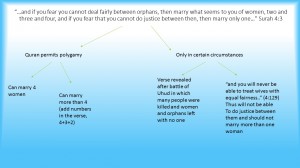Portfolio Response to We Sinful Women
ø
The collection of poems in We Sinful Women represent a feminist view in Pakistan, women rising up to act against oppressive laws and rules. We Sinful Women was an avenue for women to speak out and stand up for their rights in a society that traditionally favored men. In class, we discussed how key issues relating Islam and women have come to the forefront as women’s views are heard. For example, Benazir Bhutto, the former prime minister of Pakistan, and Shirin Ebadi, Irani activist, claim that patriarchial readings of the Quran are what cause oppression of women.
I wanted to showcase this idea by visually demonstrating how a verse in the Quran can be interpreted in a way that may benefit men more or in a a more egalitarian view. I started with the verse on the top of the page, then created a flowchart of the differing views on what that verse actually means. The first picture displays the verse about polygamy that we dicussed in class. Although it was revealed in the context of a war that killed many Muslims, some still view this verse as always permitting polygamy. In this way, it is easy to overlook aspects of a verse and interpret it in a way that benefits a certain group of people.
The second picture is a verse about the veil that we also mentioned in the class discussion. The veil has been a large topic of debate as western countries interact with Islamic countries. This verse can be interpreted to mean than women must always cover their hair and face, or could mean to simply dress modestly but not have to cover the hair. It can be difficult to determine which interpretation should be followed. However, the verse is not the only aspect to why a group may have a certain view on the issue, which I highlighted in the green box. For both pictures, I made the background a gradient with the clear white color on the top of the picture near the verse, representing the true verse directly from the Quran. The background then gets darker as it reaches the interpretations of the verse, representing the difficulty of understanding in a unified way and the murkiness of differing views on the same topic.



